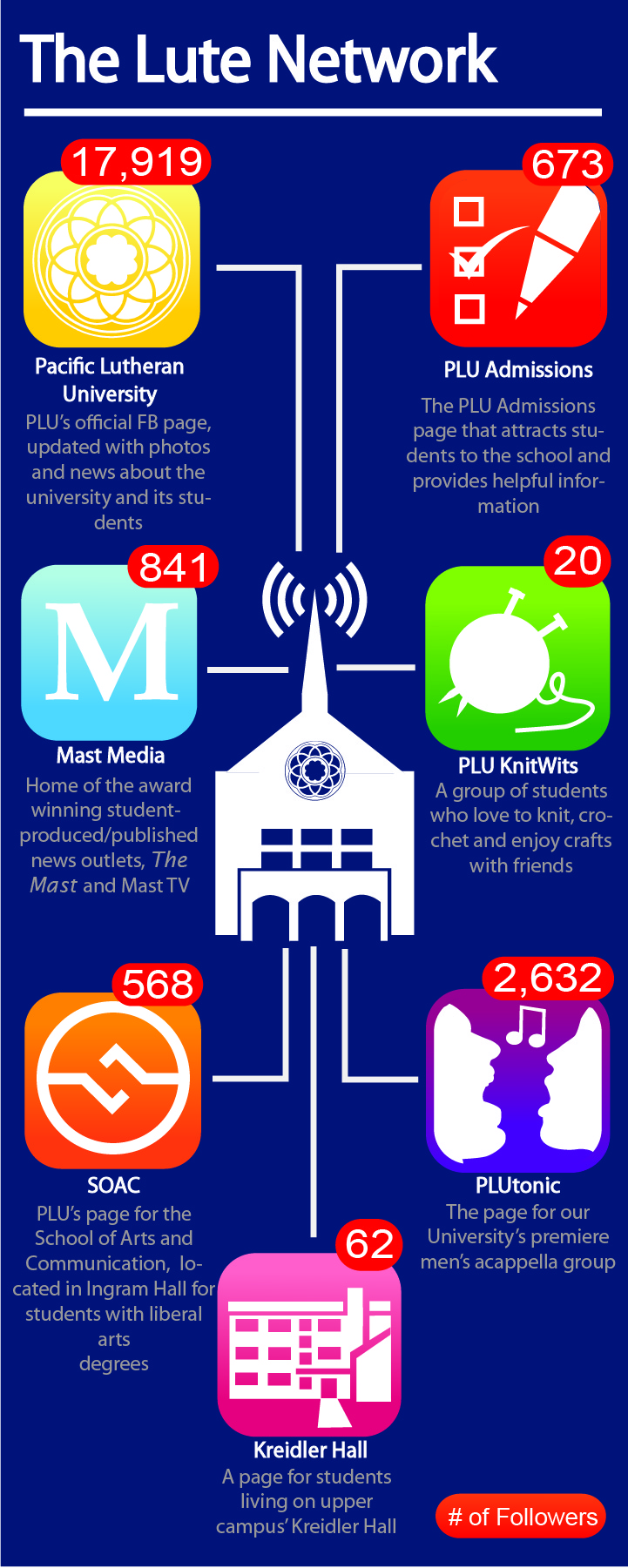There are slightly more than 3,300 students at Pacific Lutheran University, but more than 120 Facebook pages associated with PLU – roughly 5 percent of the student population is running a social media page.

Even though there’s a Residential Life page, there are individual pages for every hall on campus. There are pages for Dining and Culinary services and the Diversity Center even though there’s a Student Life page.
Is the PLU social media presence overdone or on track?
According to Social Media stakeholders on campus – both students and staff – having several pages effectively disseminates information and reinforces community.
Sophomore Joel Thomas is the Public Relations Director for the PLU Residence Hall Association which coordinates programming and advocates for students in Residential Life. He oversees the active RHA Facebook, Twitter and Instagram pages, posting about upcoming events to roughly 700 Facebook “likes” and more than 200 Twitter followers.
RHA executives work with executives at each hall’s Residential Hall Council, so part of Thomas’ job is working with each RHC’s PR Director. Since every Residence Hall has their own PR Director, each of the 10 halls also has its own social media accounts.
Thomas says this allows “more direct, personal engagement” between residents and leadership, as well as gives everyone “a sense of pride in their hall.”
The Director of Content Marketing who oversees the official PLU social media pages, Lace Smith, expressed the same thought –– rather than being redundant, the proliferation of accounts tied to the PLU residential experience allows for more connection to happen and information to be heard.
Associated Students of PLU’s Civic Engagement Director sophomore Melissa Munson runs the student government social media pages. She recognizes the ability of social media to “make sure student’s voices [are] heard” and get “the campus excited about ASPLU events.”
In terms of improvements, she said PLU could be doing more campaigns like the “It’s on US” campaign, which promoted ending sexual violence on college campuses, and further “publicize our contributions to our communities.”
Along with running PLU’s official accounts that amount to over 48,000 Facebook likes and almost 4,000 Twitter followers, she advises other social media groups across campus.
Smith compares her job to a garden: social media around campus used to be a garden without a gardener. There were some delicious vegetables and beautiful flowers in the garden, but it was also riddled with underbrush and weeds that distracted from the beauty.
Lace is the first person to be focused on gardening the PLU social media landscape. She’s done some weeding – removing some defunct Facebook pages and working to consolidate a few accounts – but she thinks that any site producing valuable content is helpful in the end.
Creating engaging, useful and utilized content isn’t easy.
“This is work,” Smith said. “It’s fun, fantastic and a great adventure, but it still needs the care and feeding.”
Besides managing content, she works with others to grow their presence. Much like teaching a garden class, she says she plans to host a social media lunch where student leaders can chat about social media from the concept to the minute details of how an event should be covered.
Thomas hasn’t declared a major. Munson is on the Pre-law track, majoring in Business. Smith studied Studio Art and finished her MBA.
While these three are some of the largest social media stakeholders on campus – due to their defined roles – none have officially studied Public Relations and Advertising, a concentration in the Communication major.
Senior Amanda Williams is a PR Student and the Public Relations Director of the co-curricular MediaLab, the student-run, faculty-advised PR firm on campus.
She understands the values Munson and Thomas express about social media; however, in her opinion as a communication scholar and practitioner, she sees a problem.
“Separate accounts are dividing the various groups rather than uniting them,” Williams said. “Students don’t want their media feeds to be bombarded with a particular organization. Instead of following every account, they will only follow the ones that directly pertain to them. Groups can’t effectively use social media if it is not reaching the target audience.”
Williams suggests moving to a consolidated system with only one PLU account that would feature diverse groups across campus.
If anyone would do that, it’d be Smith. Marketing and Communications is currently developing content hubs for plu.edu that would pool together various videos, photos and social posts from accounts across campus.
Williams’s idea, however, doesn’t appear to be in the works. A consolidated system would silence too many valuable events that may not be of campus-wide importance, Smith said, and the proliferation of media accounts end up promoting each other.
“Content comes from everywhere on campus. We don’t go in and sorta stifle or squash [all the media accounts on campus] because all the information they’re putting out just feeds up to other people,” Smith said. “It’s never in vain when you’re putting out information. It’s our job together to make sure the accounts are the best they can be. The beautiful thing about social media is that you don’t do it alone.”
Do you love social media? Follow Mast Media’s social media pages: https://www.facebook.com/PLUMastMedia


















